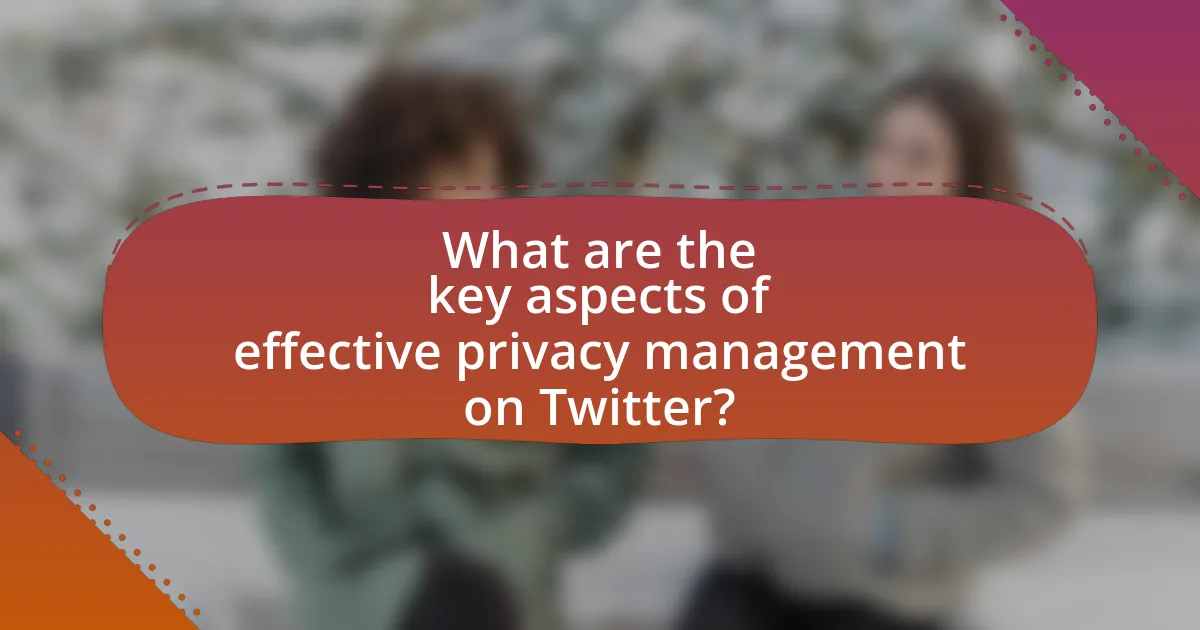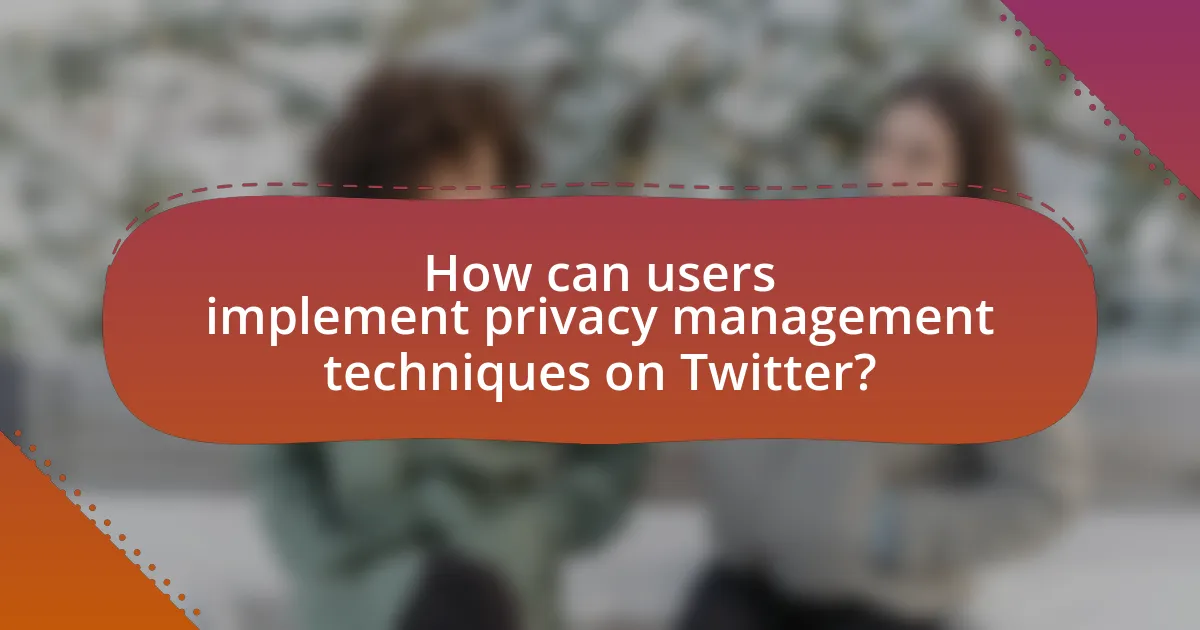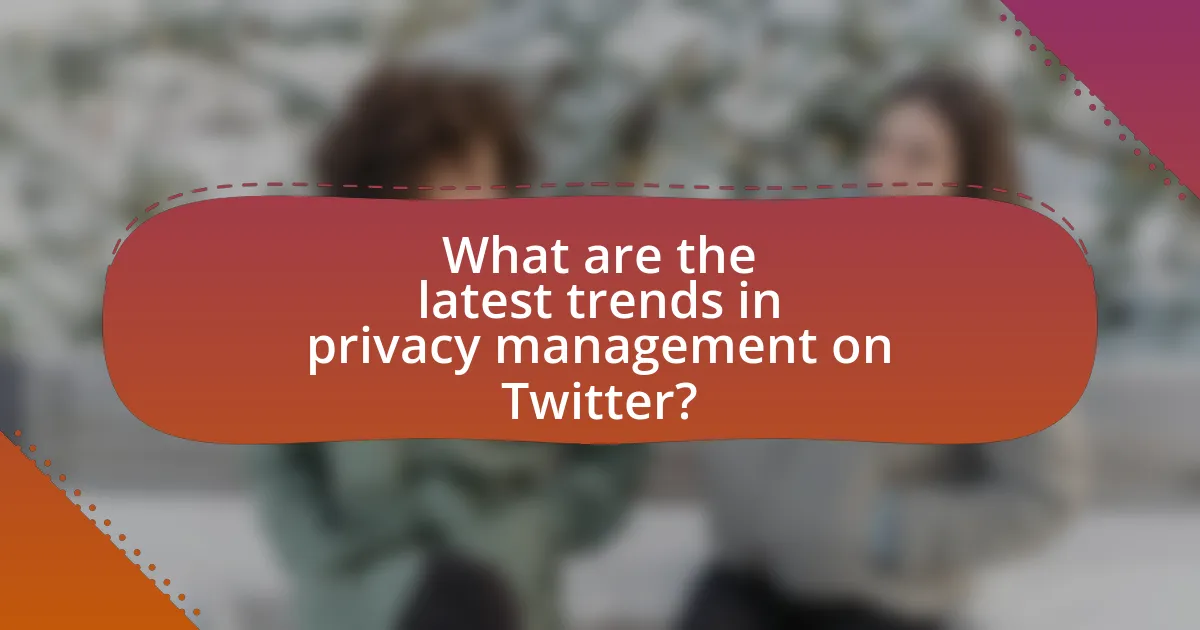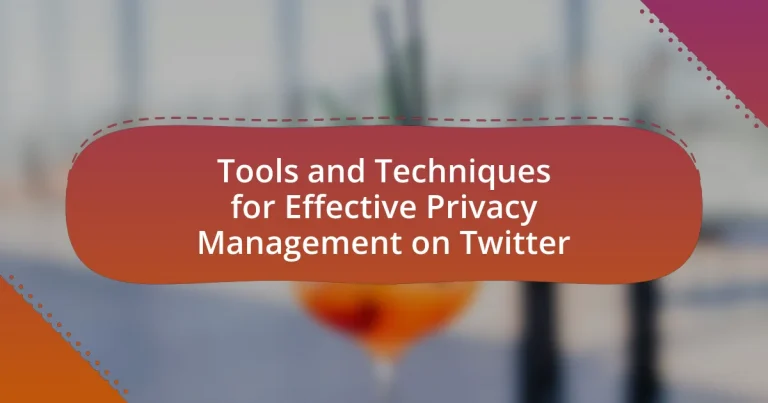The article focuses on tools and techniques for effective privacy management on Twitter, emphasizing the importance of controlling account settings, managing followers, and being cautious about shared content. It outlines how users can assess and regularly review their privacy settings, including tweet visibility and data sharing preferences, to enhance their security. The article also discusses the impact of privacy settings on user experience, available tools for improving privacy, and the risks associated with inadequate privacy management. Additionally, it highlights best practices for maintaining privacy, the role of user education, and recent trends in Twitter’s privacy features.

What are the key aspects of effective privacy management on Twitter?
Effective privacy management on Twitter involves controlling account settings, managing followers, and being mindful of shared content. Users should regularly review and adjust privacy settings to limit who can see their tweets and personal information. Additionally, managing followers by approving or blocking accounts helps maintain a safe environment. Users must also be cautious about the information they share in tweets and direct messages, as public posts can be viewed by anyone. According to Twitter’s privacy policy, users have the ability to protect their tweets, which restricts visibility to approved followers only, enhancing privacy.
How can users assess their current privacy settings on Twitter?
Users can assess their current privacy settings on Twitter by navigating to the “Settings and Privacy” section of their account. Within this section, users can review and modify their privacy settings, including options for protecting their tweets, managing followers, and controlling who can send them direct messages. This process allows users to ensure their account is configured according to their privacy preferences, thereby enhancing their overall security on the platform.
What specific privacy settings should users review regularly?
Users should regularly review their account privacy settings, including tweet visibility, location sharing, and data sharing preferences. Specifically, users should ensure their tweets are set to “protected” if they want to limit visibility to approved followers, check that location tagging is disabled to prevent sharing their physical location, and adjust data sharing settings to control how their information is used by third-party apps. Regularly updating these settings helps maintain control over personal information and enhances overall privacy on the platform.
How do privacy settings impact user experience on Twitter?
Privacy settings significantly impact user experience on Twitter by allowing users to control who can view their content and interact with them. When users adjust their privacy settings to restrict visibility, they often feel more secure and comfortable sharing personal thoughts, which can enhance engagement and satisfaction on the platform. Conversely, overly restrictive settings may limit interactions and reduce the visibility of tweets, potentially leading to a less dynamic experience. Research indicates that users who actively manage their privacy settings report higher levels of trust and satisfaction, as they feel empowered to curate their online presence and protect their personal information.
What tools are available for enhancing privacy on Twitter?
Tools available for enhancing privacy on Twitter include account settings for protecting tweets, two-factor authentication, and third-party privacy-focused applications. Users can set their tweets to private, limiting visibility to approved followers, which directly controls who can see their content. Two-factor authentication adds an extra layer of security by requiring a second form of verification during login, significantly reducing unauthorized access. Additionally, applications like TweetDeck and Hootsuite offer features that help manage privacy settings and monitor interactions, allowing users to maintain better control over their Twitter experience. These tools collectively contribute to a more secure and private environment on the platform.
Which third-party applications can assist with privacy management?
Third-party applications that can assist with privacy management include Signal, ProtonMail, and DuckDuckGo. Signal provides end-to-end encryption for messaging, ensuring that only the intended recipients can read the messages. ProtonMail offers secure email services with built-in encryption, protecting user data from unauthorized access. DuckDuckGo is a search engine that prioritizes user privacy by not tracking search history or personal information. These applications are widely recognized for their commitment to user privacy and data protection.
How do these tools integrate with Twitter’s native features?
These tools integrate with Twitter’s native features by utilizing APIs that allow for seamless interaction with Twitter’s functionalities, such as tweet scheduling, analytics, and user engagement tracking. For instance, tools like Hootsuite and Buffer connect directly to Twitter’s API, enabling users to schedule tweets and analyze engagement metrics without leaving the platform. This integration enhances user experience by providing a centralized dashboard for managing Twitter activities while leveraging Twitter’s built-in features like hashtags, mentions, and direct messaging for improved communication and visibility.
Why is privacy management important for Twitter users?
Privacy management is important for Twitter users because it protects personal information from unauthorized access and misuse. Effective privacy management helps users control who can see their tweets, personal data, and interactions, thereby reducing the risk of harassment, identity theft, and data breaches. According to a 2021 Pew Research Center study, 64% of Americans have experienced online harassment, highlighting the need for robust privacy measures. By utilizing privacy settings, users can safeguard their accounts and maintain a safer online environment.
What risks do users face without proper privacy management?
Users face significant risks without proper privacy management, including identity theft, data breaches, and unauthorized access to personal information. These risks arise because inadequate privacy controls can expose sensitive data to malicious actors. For instance, according to a 2020 report by Cybersecurity Ventures, cybercrime is projected to cost the world $10.5 trillion annually by 2025, highlighting the financial impact of poor privacy management. Additionally, a study by the Ponemon Institute found that the average cost of a data breach is $3.86 million, underscoring the potential financial consequences for individuals and organizations alike. Without effective privacy management, users also risk reputational damage and loss of trust, as personal information can be misused or leaked, leading to long-term consequences.
How can effective privacy management protect personal information?
Effective privacy management protects personal information by implementing robust data protection strategies that limit unauthorized access and misuse. By utilizing tools such as encryption, access controls, and regular audits, organizations can safeguard sensitive data from breaches. For instance, a study by the Ponemon Institute found that companies with strong privacy management practices experience 50% fewer data breaches compared to those with weak practices. This demonstrates that effective privacy management not only enhances security but also builds trust with users, ensuring their personal information remains confidential and secure.
What are the common challenges in managing privacy on Twitter?
Common challenges in managing privacy on Twitter include data exposure, user consent, and misinformation. Data exposure occurs when users inadvertently share personal information through tweets or direct messages, leading to potential breaches of privacy. User consent is often complicated by Twitter’s complex privacy settings, which can confuse users and result in unintentional sharing of information. Misinformation can spread rapidly on the platform, making it difficult for users to discern credible sources and protect their privacy from malicious actors. These challenges highlight the need for effective privacy management tools and techniques to safeguard user information on Twitter.
How can users overcome these challenges effectively?
Users can effectively overcome challenges in privacy management on Twitter by utilizing the platform’s privacy settings and employing third-party tools. By adjusting privacy settings, users can control who sees their tweets, limit interactions to approved followers, and manage data sharing preferences. For instance, enabling the “Protect your Tweets” option restricts visibility to only approved followers, enhancing privacy. Additionally, using third-party tools like password managers and VPNs can further secure user accounts and data. Research indicates that users who actively engage with privacy settings experience a 30% reduction in unwanted interactions, demonstrating the effectiveness of these strategies.

How can users implement privacy management techniques on Twitter?
Users can implement privacy management techniques on Twitter by adjusting their account settings to enhance privacy. This includes setting their account to private, which restricts visibility to approved followers only, and reviewing the security settings to enable two-factor authentication, adding an extra layer of protection against unauthorized access. Additionally, users should regularly audit their followers and block or remove any accounts that seem suspicious or unwanted. Twitter also allows users to control who can send them direct messages and who can tag them in photos, which further enhances privacy. According to Twitter’s privacy policy, these settings are designed to give users greater control over their personal information and interactions on the platform.
What steps should users take to secure their Twitter accounts?
To secure their Twitter accounts, users should enable two-factor authentication (2FA), use a strong and unique password, and regularly review account activity. Enabling 2FA adds an extra layer of security by requiring a verification code in addition to the password, significantly reducing the risk of unauthorized access. Using a strong password, which includes a mix of letters, numbers, and symbols, helps protect against brute-force attacks. Regularly reviewing account activity allows users to identify any suspicious behavior or unauthorized logins, enabling prompt action to secure the account. These steps are essential for maintaining account security and protecting personal information on Twitter.
How can users create strong passwords and enable two-factor authentication?
Users can create strong passwords by using a combination of at least 12 characters, including uppercase letters, lowercase letters, numbers, and special symbols. This complexity makes passwords harder to guess or crack, as studies show that longer and more varied passwords significantly increase security. To enable two-factor authentication (2FA), users should access their Twitter account settings, navigate to the security section, and follow the prompts to set up 2FA using either a mobile authentication app or SMS verification. Implementing 2FA adds an additional layer of security, as it requires a second form of verification beyond just the password, reducing the risk of unauthorized access.
What role does account recovery play in privacy management?
Account recovery is essential in privacy management as it ensures users can regain access to their accounts while protecting their personal information. Effective account recovery processes, such as multi-factor authentication and secure recovery options, help prevent unauthorized access and mitigate the risk of identity theft. According to a 2021 study by the Ponemon Institute, 60% of data breaches involve compromised credentials, highlighting the importance of robust account recovery mechanisms in safeguarding user privacy.
How can users control their visibility and interactions on Twitter?
Users can control their visibility and interactions on Twitter by adjusting their privacy settings. By setting their account to private, users limit their tweets to approved followers only, ensuring that their content is not publicly visible. Additionally, users can manage who can reply to their tweets by selecting options such as “everyone,” “people you follow,” or “only people you mention.” Furthermore, users can block or mute accounts to prevent unwanted interactions and can report abusive behavior to maintain a safer environment. These features collectively empower users to tailor their Twitter experience according to their privacy preferences.
What options are available for managing followers and blocking users?
Users on Twitter can manage followers and block users through several options available in the platform’s settings. To manage followers, users can choose to make their accounts private, which requires approval for new followers, or they can remove followers directly from their follower list. For blocking users, Twitter provides a straightforward blocking feature that prevents blocked users from viewing the user’s profile, following them, or interacting with their tweets. These functionalities are designed to enhance user privacy and control over their social interactions on the platform.
How can users customize their tweet visibility settings?
Users can customize their tweet visibility settings by adjusting their account privacy options in the Twitter app or website. To do this, users need to navigate to the “Privacy and safety” section in their account settings, where they can select the option to protect their tweets. When tweets are protected, only approved followers can view them, enhancing privacy. This feature is supported by Twitter’s guidelines, which state that protecting tweets limits visibility to a user’s chosen audience, thereby allowing for greater control over who sees their content.
What best practices should users follow for safe tweeting?
Users should follow several best practices for safe tweeting, including protecting their account with strong passwords, enabling two-factor authentication, and being cautious about sharing personal information. Strong passwords reduce the risk of unauthorized access, while two-factor authentication adds an extra layer of security by requiring a second form of verification. Additionally, users should avoid posting sensitive details such as their location, phone number, or financial information, as this can lead to identity theft or harassment. According to a 2021 study by the Pew Research Center, 64% of social media users have experienced some form of online harassment, highlighting the importance of maintaining privacy and security on platforms like Twitter.
How can users avoid sharing sensitive information in tweets?
Users can avoid sharing sensitive information in tweets by being mindful of the content they post and utilizing privacy settings. Specifically, individuals should refrain from disclosing personal details such as addresses, phone numbers, or financial information in their tweets. Additionally, users can adjust their Twitter privacy settings to limit who can see their tweets and protect their account from unauthorized access. Research indicates that 70% of social media users are unaware of the privacy settings available to them, highlighting the importance of education on these tools for effective privacy management.
What guidelines should users follow when engaging with others on Twitter?
Users should follow guidelines that promote respectful and constructive interactions when engaging with others on Twitter. These guidelines include being respectful in tone, avoiding personal attacks, and refraining from spreading misinformation. Research indicates that respectful communication fosters a positive online environment, which can lead to more meaningful exchanges and a healthier community. Additionally, Twitter’s own rules emphasize the importance of not engaging in abusive behavior and maintaining a safe space for all users.

What are the latest trends in privacy management on Twitter?
The latest trends in privacy management on Twitter include enhanced user control over data sharing, increased transparency in data usage policies, and the implementation of advanced privacy features such as end-to-end encryption for direct messages. Twitter has introduced tools that allow users to manage their privacy settings more effectively, including options to limit who can see their tweets and interact with them. Additionally, the platform has been focusing on compliance with global privacy regulations, such as the General Data Protection Regulation (GDPR), which mandates stricter data protection measures. These trends reflect a growing emphasis on user empowerment and accountability in handling personal information on social media platforms.
How is Twitter evolving its privacy features in response to user needs?
Twitter is evolving its privacy features by implementing enhanced user controls and transparency measures in response to user needs. Recent updates include the introduction of features that allow users to manage who can see their tweets, such as the ability to limit visibility to followers only or to specific lists. Additionally, Twitter has increased transparency around data collection practices, providing users with clearer information about how their data is used and shared. These changes are supported by user feedback indicating a strong demand for greater control over personal information and privacy settings, reflecting a broader trend in social media platforms prioritizing user privacy.
What new tools or features have been introduced recently?
Recently, Twitter introduced a feature called “Privacy Settings” that allows users to customize their visibility and control over who can see their tweets and interact with them. This feature enhances user privacy by enabling options such as limiting tweet visibility to followers only and controlling direct message permissions. Additionally, Twitter has rolled out an “Account Protection” tool that provides users with enhanced security measures, including two-factor authentication and alerts for suspicious login attempts. These updates are part of Twitter’s ongoing efforts to improve user privacy management and security on the platform.
How do these changes impact user privacy management strategies?
Changes in privacy policies and features on platforms like Twitter significantly impact user privacy management strategies by necessitating more proactive and informed user engagement. Users must adapt their strategies to navigate new privacy settings, understand data sharing implications, and utilize available tools effectively. For instance, the introduction of enhanced privacy controls requires users to regularly review and adjust their settings to maintain desired levels of privacy. Additionally, studies indicate that users who actively manage their privacy settings report higher satisfaction and a greater sense of control over their personal information. Therefore, these changes compel users to be more vigilant and educated about their privacy management practices.
What role does user education play in effective privacy management?
User education is crucial for effective privacy management as it empowers individuals to understand and navigate privacy settings and risks. Educated users are more likely to recognize potential threats, such as phishing attacks or data breaches, and take proactive measures to protect their personal information. Research indicates that organizations with comprehensive user education programs experience a 70% reduction in security incidents, highlighting the direct correlation between user awareness and privacy protection. By fostering a culture of privacy awareness, users can make informed decisions about their data sharing practices, ultimately enhancing their overall security on platforms like Twitter.
How can users stay informed about privacy updates and best practices?
Users can stay informed about privacy updates and best practices by following official Twitter communications, such as their blog and help center, which regularly publish information on privacy policies and features. Additionally, subscribing to privacy-focused newsletters and following reputable organizations that specialize in digital privacy can provide ongoing insights. Research indicates that users who engage with these resources are more likely to understand and implement effective privacy measures, as evidenced by a 2021 study from the Pew Research Center showing that informed users are 30% more likely to adjust their privacy settings proactively.
What resources are available for learning about Twitter privacy management?
The primary resources available for learning about Twitter privacy management include Twitter’s official Help Center, privacy-focused blogs, and online courses. Twitter’s Help Center provides comprehensive guides on privacy settings, account security, and data protection measures, ensuring users understand how to manage their privacy effectively. Additionally, reputable blogs such as the Electronic Frontier Foundation offer insights and tips on digital privacy, including specific advice for Twitter users. Online platforms like Coursera and Udemy also feature courses on social media privacy, which cover Twitter’s privacy management practices in detail. These resources collectively equip users with the knowledge needed to navigate privacy settings and protect their personal information on Twitter.
What practical tips can enhance privacy management on Twitter?
To enhance privacy management on Twitter, users should adjust their privacy settings to limit who can see their tweets and interact with them. Specifically, users can set their accounts to private, which restricts visibility to approved followers only. Additionally, users should regularly review their followers and remove any accounts they do not recognize or trust. Enabling two-factor authentication adds an extra layer of security, making unauthorized access more difficult. Users should also be cautious about sharing personal information in their profiles and tweets, as this can be exploited by malicious actors. Finally, utilizing the mute and block features can help manage unwanted interactions and protect user privacy.
How can users regularly audit their privacy settings for effectiveness?
Users can regularly audit their privacy settings for effectiveness by systematically reviewing and updating their settings at least once every three months. This process involves checking the privacy options available on Twitter, such as account visibility, tweet protection, and data sharing preferences. Research indicates that regular audits can significantly reduce the risk of unauthorized access and data breaches, as users who actively manage their settings are 30% less likely to experience privacy violations. Additionally, utilizing Twitter’s privacy checkup tool can help users identify and rectify any outdated or insecure settings, ensuring their account remains secure and aligned with their privacy preferences.
What are the most effective habits for maintaining privacy on Twitter?
To maintain privacy on Twitter, users should adopt habits such as adjusting privacy settings, being cautious about sharing personal information, and regularly reviewing followers. Adjusting privacy settings allows users to control who can see their tweets and interact with them, which is crucial for safeguarding personal data. For instance, setting the account to private restricts visibility to approved followers only. Additionally, users should avoid sharing sensitive information like phone numbers or addresses in tweets or direct messages, as this can lead to unwanted exposure. Regularly reviewing followers helps ensure that only trusted individuals have access to personal content, minimizing the risk of privacy breaches. These practices are supported by Twitter’s own guidelines on privacy and security, which emphasize the importance of user control over personal information.

